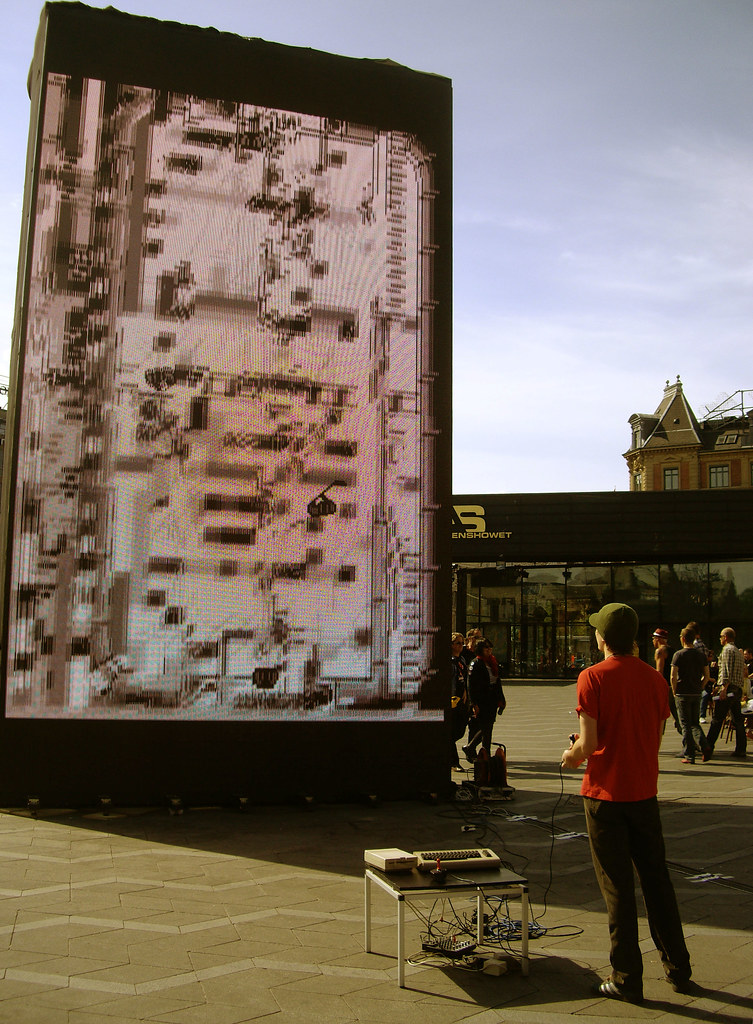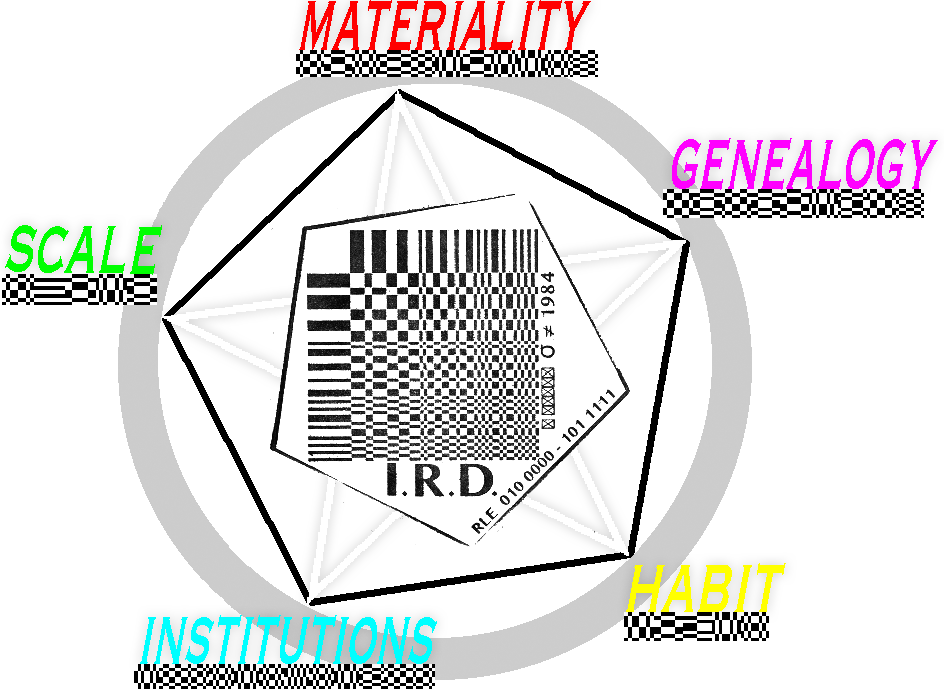the medium is the message: because it is the medium that shapes and controls the scale and form of human association and action. The content or uses of such media are as diverse as they are ineffectual in shaping the form of human association. Indeed it is only too typical that the "content" of any medium blinds us to the character of the medium.5In digital glitch art, a void is often used not only as a means to perceive, it is especially a lack of meaning, often a place where a medium is used in a subversive way and where the expected, conventional message of the medium is destroyed. Through means of the void, the medium can be redefined as a platform that doesn’t follow the conventions and triggers the user to reflect upon his conventional frames of reference and criticize the flow, which is often taken for granted and even constitutes our Zeitgeist. The void, created by a glitch obliges the viewer to start making sense and meaning more actively and to consider the computer no longer just as a device of standardization but instead as a technology that functions within a social reality. The ‘techniques of the void’ and systematically distorted communication (glitches) are helpful because they open up possibilities for discussing technologies and their internal politics. Through these tactics we can ‘reterritorialize’ our environment and therefore ourselves. HT Gold is an allegorical, critical exploration of the heterogonous expectation present day capitalism has cultivated. The destructive nature of the glitch becomes constructive within this work. It is cipher, eluding fixed definitions of the medium, while shocking the continuum of history and taking the viewer towards a new now, an utopia where capitalism doesn’t infect media and it usage. The unwanted glitches in both the sounds and the visuals of HT Gold have a reflexive worth, that present the viewer with multiple ways think about a medium, not as a medium for competition, but as a generative medium with endless possibilities. 1. Baudrillard, Jean. Simulacra and Simulation. Michigan: University of Michigan Press, 1994. p. 79 2. HT Gold was presented as an installation art work at the Re:New festival in Copenhagen in 2008 and runs on the Commodore 64. Flickr Blip.tv 3. GOTO8O Blog Archive C-64 installation: HT Gold. 4. Debord, Guy. 1981. “Theory of the Dérive”. In K. Knabb (Ed.), The Situationist International Anthology. Berkeley: Office of Public Secrets: 50-54. 5. Mcluhan, Marshall. Understanding Media: The Extensions of Man. New York: McGraw Hill, 1964.
10/14/2008
In the midst of the serene world of ɥɔʇılƃ
HT Gold (Autoboy and Goto80, Commodore 64: Sweden, 2008))
Right: HT Gold on the Copenhagen Radhuspladsen during Re:New Festival.
Be aware that the framerate of a Commodore 64 is 50 frs and needs to be recorded in progressive scan mode - something that I cannot do at home. The recording that I made, as seen above, is a recording in which all the frames seems to be mashed together to fit into 25frs, which make it look really different from the original, which flickers massively but is a lot more clear at the same time.
HT Gold will be playable at HAIP Festival in Ljubljana in November (on the commodore, of course). Radio Dada will also be shown there.
Here is a review based on some heavy Capitalism centered interpreting from my side.
In Capital: A Critique of Political Economy, Marx described how capitalism both fragmented and unified the world through its transformational logic of commodification. Through the heterogeneity of the marketplace all products became smudged with the same political and social dimensions. This heterogeneity has become a basic principle of Capitalism and is often described as flow, starting with Guy Debords’ Society of the Spectacle. In the Society of the Spectacle, all images have become empty and meaningless, or as Baudrillard wrote in the 80s, their meaning has imploded.1
In 1957 Debord founded the Situationist International, a collective that developed several social-aesthetic practices that could be used to interrupt the cultural systems of advanced capitalism. One of these practices is the process of detournement, which means to repurpose parts of the spectacle to expose its internal logic. As a result, the flow and conventions behind a platform become apparent. This technique is widely used even amongst modern (digital) artists like Jodi, ®TMark or Mark Napier, who often seem to subvert the prevailing meaning of an interface, object or medium to make the user aware of their expectations and conventions.
The modified videogame HT Gold is a videogame installation that doesn’t seem to answer to the still governing norms indebted within our present society.2 At first sight this peculiar piece could easily be abolished by the presupposition that it descends from another period; the ancient videogame console could be understood as just another old remnant from the long overtaken 80s, receiving its last glory as a ruined hieroglyph from the past.
But as the visitor takes more interest in the work, he will notice that in fact, contrasting to that the ordinary viewer would perceive as a void of meaning, HT Gold is not just a ruined installation. It actually functions very well, but just on a different level then the viewer was aware of at first sight. HT Gold is an intentionally ruined videogame that questions all the conventions that even after 20 years, still rule the videogame battlefield. It redefines its platform through the use of what I would like to argue is similar to detournement.
HT Gold is based on a competitive ice hockey game called Hat Trick (Capcom, Bally/Midway, 1987) programmed for the Commodore 64. Through changing the code of the original game, it has become a game with improved functionality and less competition.3 In short, the algorithms that define its playability, the laws of physics, steering and scoring have been destabilized, while the music has been replaced with a new song that synthesizes the original sound effects by "ring modulation", a feature of the C64 sound chip. A use of technique that answers perfectly to Russolos quest to expand the limited circle of sounds accepted by modern composition to include the infinite variety of noise sounds or, as Varese declared, to liberate sound.
The modified algorithms, visuals and sounds generate a new ensemble; in which winning is still possible but can’t be controlled anymore. The visual and the audible have gain importance over competition and the outcome of a game is no longer a score but a colorful, musical experience. In terms of detournement, the videogame code has been repurposed from a sensible game engine into an art generation tool.
The ‘journey’ that the duo from Sweden have undertaken while making the artwork could also be described in terms of Debord, namely as a dérive. The dérive is a trip with no destination. It means to go off course, to stray, or to wander while being aware of the psycho-geographical effects of your environment.4 In the case of HT Gold this wandering took place when the artists had a walk through the ‘coded environment’ and changed it, with no other purpose then to revisit the way they looked at the videogame. Moreover, playing the game itself has become a dérive, because while the game develops, the steering is guided more and more by the psycho geographical effects of the game; the player loses a sense of final destination like winning, because winning becomes more and more impossible throughout the game.
Through its changed code, HT Gold plays with conventions that are part of the original genre of the videogame, but also the expectations of the spectator and the behavior of the interface. The artwork can be understood as a struggle against the technological determinist attitude of the consumer, which McLuhan already described in the 60s. To McLuhan, technological developments were the most important reasons for cultivation. He states that not the content, but the medium itself should be the subject of study.
Subscribe to:
Post Comments (Atom)





4 comments:
Interesting text and artwork. I'm finnish video artist currently writing text about how YouTube can be interpreted with situationist theories. Your text brought some interesting viewpoints to my thoughts. Keep on détourning :)
hello rosa!!
Lars here (from malmö)... nice bloog i will read more later :)
say hello to goto80
:)
o yeah pass by malmö more times... you are always welcome,, and we'll try to visit u in amsterdam in april or something :)
I heard from the rest of the s23x crew of your presence! I hope you enjoyed the bus!
Post a Comment